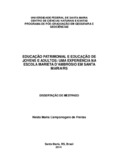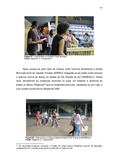| dc.creator | Freitas, Neida Maria Camponogara de | |
| dc.date.accessioned | 2015-03-27 | |
| dc.date.available | 2015-03-27 | |
| dc.date.issued | 2014-05-30 | |
| dc.identifier.citation | FREITAS, Neida Maria Camponogara de. Heritage education and young and adult education: an experiment in Marieta D` Ambrósio School in Santa Maria, RS. 2014. 222 f. Dissertação (Mestrado em Geociências) - Universidade Federal de Santa Maria, Santa Maria, 2014. | por |
| dc.identifier.uri | http://repositorio.ufsm.br/handle/1/9417 | |
| dc.description.abstract | Thinking of public school in the context of formal education, as the institution responsible for
the basic training of most Brazilian citizens, it is important to approach the Heritage
Education in the school curriculum. This study will focus the trend analysis of cultural
freeholds which approach their relations with the identities and memories of a place, linked to
the people who live there and enjoy the collective environments in their daily lives. It
constitutes therefore an important link to the cultural formation of the individual related to the
different realities, seeking to expand their knowledge in the formation of their citizenship. The
main goal of this research was to investigate how educational activities planned on the
Cultural Heritage may contribute to the understanding of the place of living of the students of
the Youth and Adult Education (EJA), from the Public Elementary School Marietta
D'Ambrosio in the city of Santa Maria. Thereunto, several educational activities were planned
on cultural freeholds around the school, expanding educational activities for the Historical
Center of the city of Santa Maria, RS. The specific goals of the survey were: understand the
sociocultural reality of the students from EJA; understand how the students from EJA
perceive cultural property from educational activities in different locations around the city;
analyze how educational activities on local cultural freeholds can contribute to the
understanding of the place of living of the students from EJA; identify how heritage education
can be addressed in the curriculum of EJA. Based on this assumption, this paper presents
some results and thoughts related to this theme from the experiences lived by the students in
understanding the questions and proposals according to the objectives of this survey. It was
defined as an investigative method the action-survey, developed in three different stages: a)
literature review of concepts by authors that theoretically underlie the issue and analysis of
existing legislation; b) data collection from secondary sources through analysis of
iconographic and textual documents on cultural freeholds under study; c) empirical data
collection on the articulation of the cultural heritage of the city through educational activities.
The results revealed that for most students the actions of Heritage Education on cultural local
freeholds increased their knowledge about the historical places in the city, providing
knowledge about many places that they did not know or did not attribute value. Besides
having experienced moments of collective living, which marked the educational process in
the school, it was observed the emergence of ties to the city where they live, as well as the
comprehension of the importance of knowing to attribute value and assign meaning to the
different cultures that permeate the collective spaces, in the representation of distinct social
groups through the time. It was also gathered some subsidies to promote progress and
improvement on the practice of heritage education which can be developed in schools. | eng |
| dc.format | application/pdf | por |
| dc.language | por | por |
| dc.publisher | Universidade Federal de Santa Maria | por |
| dc.rights | Acesso Aberto | por |
| dc.subject | Educação patrimonial | por |
| dc.subject | Patrimônio cultural | por |
| dc.subject | EJA | por |
| dc.subject | Heritage education | eng |
| dc.subject | Cultural heritage | eng |
| dc.subject | Young and adult education (EJA) | eng |
| dc.title | Educação patrimonial e educação de jovens e adultos: uma experiência na Escola Marieta D` Ambrósio em Santa Maria/RS | por |
| dc.title.alternative | Heritage education and young and adult education: an experiment in Marieta D` Ambrósio School in Santa Maria, RS | eng |
| dc.type | Dissertação | por |
| dc.description.resumo | Pensando-se a escola pública no contexto da educação formal, como a Instituição responsável
pela formação básica da maioria dos cidadãos brasileiros, faz-se relevante aproximar a
Educação Patrimonial do currículo escolar. Este estudo estará enfocando a tendência de análise
dos bens culturais que abordam as suas relações com as identidades e memórias de um lugar,
vinculado às pessoas que ali vivem e desfrutam dos ambientes coletivos no seu cotidiano.
Constitui-se pois, importante elo na formação cultural do indivíduo diante das diferentes
realidades, visando ampliar seus conhecimentos, na formação de cidadãos mais plenos. Teve-se
como objetivo central desta pesquisa, investigar como ações educativas planejadas sobre o
Patrimônio Cultural podem contribuir para ampliar o conhecimento do lugar de vivência dos
alunos da Educação de Jovens e Adultos (EJA), da Escola Estadual de Ensino Fundamental
Marieta D Ambrósio, na cidade de Santa Maria. Para isso, foram planejadas diversas ações
educativas sobre os bens culturais no entorno da escola, ampliando-se as ações educativas para
o Centro Histórico da cidade de Santa Maria, RS. Foram definidos como objetivos específicos da
pesquisa: conhecer a realidade sociocultural dos alunos da EJA; compreender como os alunos
da EJA percebem os bens culturais a partir de ações educativas em diferentes locais da cidade;
analisar como ações educativas sobre os bens culturais locais podem contribuir para ampliar o
conhecimento do lugar de vivência dos alunos da EJA; identificar como a educação patrimonial
pode ser contemplada no currículo da EJA. Partindo desse pressuposto, este trabalho visa
apresentar alguns resultados e reflexões que envolvem essa temática, a partir das experiências
vivenciadas pelos educandos, na compreensão das indagações propostas e conforme os
objetivos desta pesquisa. Definiu-se como método investigativo a pesquisa-ação, desenvolvido
em três diferentes etapas: a) revisão bibliográfica de conceitos através de autores que
fundamentam teoricamente o tema e revisão da legislação em vigor; b) coleta de dados em
fontes secundárias através da análise de documentos iconográficos e textuais sobre os bens
culturais em estudo; c) coleta de dados empíricos na articulação do patrimônio cultural da cidade
através das ações educativas. Os resultados revelaram que para a maioria dos educandos as
ações de Educação Patrimonial sobre os bens culturais locais, ampliaram o conhecimento dos
lugares de patrimônio cultural da cidade, propiciando conhecer diversos lugares que não
conheciam ou que não atribuíam valor. Além de terem experienciado momentos de vivência
coletiva, que marcaram o processo educativo na escola, evidenciou-se, o surgimento de vínculos
com a cidade onde moram. Bem como, a compreensão da importância de conhecer para
valorizar e atribuir significados às diferentes culturas que permeiam os espaços coletivos, na
representação de grupos sociais distintos através dos tempos. Reuniu-se também, alguns
subsídios na promoção de avanços e melhorias das práticas de Educação Patrimonial possíveis
de serem realizadas no âmbito escolar. | por |
| dc.contributor.advisor1 | Figueiredo, Lauro César | |
| dc.contributor.advisor1Lattes | http://lattes.cnpq.br/8844649866876040 | por |
| dc.contributor.referee1 | Meurer, Ane Carine | |
| dc.contributor.referee1Lattes | http://lattes.cnpq.br/6724702305350914 | por |
| dc.contributor.referee2 | Gil, Carmem Zeli de Vargas | |
| dc.contributor.referee2Lattes | http://lattes.cnpq.br/4076880245658201 | por |
| dc.creator.Lattes | http://lattes.cnpq.br/1758487874763656 | por |
| dc.publisher.country | BR | por |
| dc.publisher.department | Geografia | por |
| dc.publisher.initials | UFSM | por |
| dc.publisher.program | Programa de Pós-Graduação em Geografia | por |
| dc.subject.cnpq | CNPQ::CIENCIAS HUMANAS::GEOGRAFIA | por |



